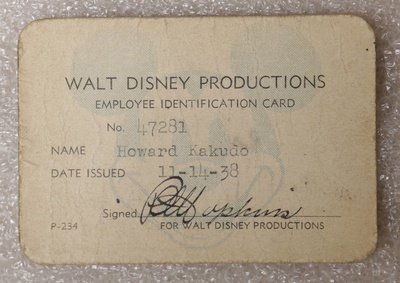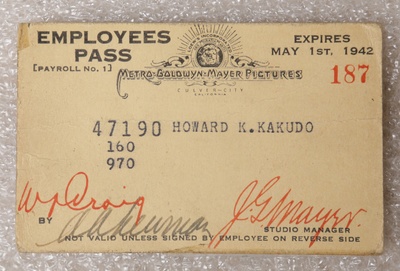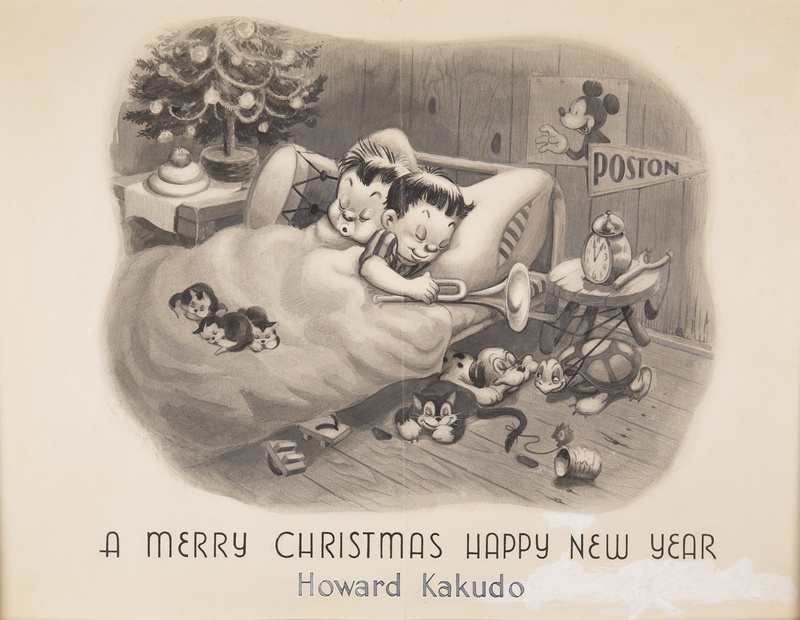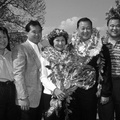In seeking to preserve and share the Japanese American experience, the Japanese American National Museum maintains the largest collection of its kind in the world. While clearly a serious and scholarly endeavor, the collection also contains items that touch on popular culture and (dare we say) are fun.
The holiday card created by Howard Kakudo while at the World War II Poston concentration camp in Arizona, is such an item. Kakudo worked in animation for Walt Disney Productions before the war on such iconic projects as Snow White and the Seven Dwarfs (1937) and Pinocchio (1940). His camp drawing depicting two sleeping children and the menagerie of cats along with a dog and a turtle evokes the Disney aesthetic (including the image of Mickey Mouse on the wall).
Historically, the drawing is important since it makes clear that this holiday scene is all happening in an American concentration camp. Kakudo places the Poston banner on the wall. The wooden floor and walls are drawn with knotholes, a feature often mentioned by camp inmates. Finally, Kakudo inserts a pair of geta underneath the bed and a kagami mochi on the table next to the Christmas tree so you know this is a Japanese New Year.
“The items that Kakudo donated to JANM’s permanent collection reveal his influence on Hollywood image-making as well as the ways in which the industry shaped his own creative aesthetic,” explained Kristen Hayashi, JANM Collections Manager. “He also incorporated the style that he learned while working for some of the large animation studios into the artwork he made at Poston as well as the cartoons he created for newspapers in Japan before WWII.”

Kakudo himself is a little bit of a mystery, even to his own daughter Elaine Shimizu. What is known is that he was forced to leave California along with thousands of people of Japanese ancestry by the US government. To his fellow Poston inmates, Howard was the Disney animator. He taught art courses and was distinctly remembered by one of his students: famed Nisei playwright Wakako Yamauchi.
“Howard had worked at Disney for two years on the ‘Blue Fairy’ character in Pinocchio,” Yamauchi wrote 50 years after the war. She also was quoted in an interview, “Words Matter: Conversations with Asian American Writers,” that Kakudo “was very, very handsome.” Yamauchi recalled that Kakudo was friends with world famous sculptor Isamu Noguchi, who volunteered to live in Poston until he tired of the conditions and left. Even in the typed minutes of a Poston block managers’ meeting, Kakudo, who lived in Block 22, was identified as “an artist for Walt Disney before evacuation” who wanted to speak at the meeting.

On the other hand, the basic details about Kakudo’s life are not always clear. On various sites, his year of birth is listed as 1907, 1908, and 1909. His daughter said that when he died in 2000, he was 93. Elaine explained that her father was born in Okayama, Japan, but was given up for adoption to a couple who had no children. The Kakudo family then moved to Seattle when Howard was four.
How her father ended up leaving Seattle for California is not completely understood by Elaine. The youngest daughter of Howard and Dorothy (nee Sato) Kakudo, Elaine’s parents divorced after the war, creating even more separation in the family. She had an older brother named Dan (11 years her senior), who has since passed away along with her parents, so she doesn’t have anyone to answer her questions.
In examining the material Kakudo donated to JANM, Hayashi saw the ways Howard used his artistic talents to make a living. “He re-created the likenesses of some of the Hollywood film industry’s most beloved stars of the 1930s, including Rudolph Valentino and Carole Lombard,” she revealed. “He depicted popular actresses Kay Francis and Sylvia Sydney for illustrated covers of 1930s issues of Cinelandia, a Hollywood Spanish language fan magazine.”

After the war, he worked as an animator on a short cartoon, “Rudolph the Red Nosed Reindeer” (1948), which was directed by Max Fleischer. Only eight minutes in length, the cartoon was actually commissioned by Montgomery Ward. Fleischer, who is famous for his own studio work including Popeye, Betty Boop, and Koko the Clown, brought in Kakudo to work on this project.
Elaine said that her parents met in Poston and when they left camp, they moved to New Jersey, where she and her brother grew up. Elaine recalled that her father used to commute to New York City and Philadelphia for work. She said at one point, he was employed by Hanna Barbara on their famous cartoon duo, Tom and Jerry.
Hayashi said that “Kakudo’s collection is notable since it’s representative of the talents of numerous Nisei artists who made significant contributions to popular culture in America as well as abroad in the pre-WWII era, by creating images that appealed to a broad and diverse audience.”
Like other pre-war Japanese American Disney animators such as Tom Okamoto, James Tanaka, Masao Kawaguchi, Chris Ishii, and Robert Kuwahara, Kakudo had a natural talent for drawing and sketching. Elaine said her father told her that when he first began working at Disney Studios as an animator, he was admonished by his fellow artists for “working too fast.”
About her father’s striking good looks, Elaine remembered that her father was actually recruited to be in the silent motion pictures. Howard told his daughter that people said he resembled another famous movie star at the time. Not Sessue Hayakawa, but Rudolph Valentino! “Something about his nose,” Elaine added. But her father was reluctant and when talkies came in, his opportunity vanished.

If Howard Kakudo is not famous, his work with Disney, Hanna Barbara, and Max Fleischer will sustain his legacy. But this New Year’s card probably reveals more about him as a Japanese American and his collection helps JANM preserve and share an important chapter in US history.
© 2019 Chris Komai






